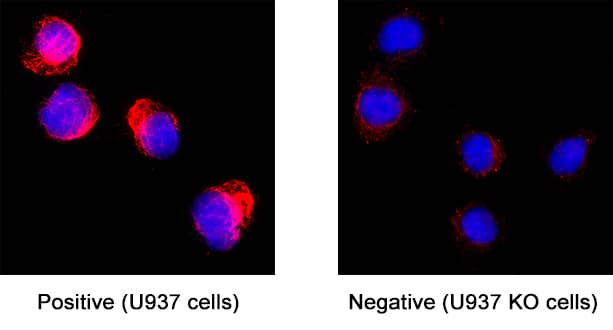Human GFAP Antibody
R&D Systems, part of Bio-Techne | Catalog # MAB2594


Conjugate
Catalog #
Key Product Details
Validated by
Knockout/Knockdown
Species Reactivity
Validated:
Human
Cited:
Human, Mouse, Transgenic Mouse
Applications
Validated:
Knockout Validated, Western Blot, Immunocytochemistry, Simple Western
Cited:
Immunohistochemistry, Immunocytochemistry
Label
Unconjugated
Antibody Source
Monoclonal Mouse IgG1 Clone # 273807
Product Specifications
Immunogen
E. coli-derived recombinant human GFAP
Leu292-Met432
Accession # P14136
Leu292-Met432
Accession # P14136
Specificity
Detects human GFAP in direct ELISAs and Western blots.
Clonality
Monoclonal
Host
Mouse
Isotype
IgG1
Scientific Data Images for Human GFAP Antibody
Detection of Human GFAP by Western Blot.
Western blot shows lysates of human brain (motor cortex) tissue, human brain (cerebellum) tissue, and human brain (hypothalamus) tissue. PVDF membrane was probed with 1 µg/mL of Mouse Anti-Human GFAP Monoclonal Antibody (Catalog # MAB2594) followed by HRP-conjugated Anti-Mouse IgG Secondary Antibody (Catalog # HAF018). Specific bands were detected for GFAP at approximately 35-50 kDa (as indicated). This experiment was conducted under reducing conditions and using Immunoblot Buffer Group 1.GFAP in Rat Cortical Stem Cells.
GFAP was detected in immersion fixed differentiated rat cortical stem cells using Mouse Anti-Human GFAP Monoclonal Antibody (Catalog # MAB2594) at 10 µg/mL for 3 hours at room temperature. Cells were stained using the NorthernLights™ 557-conjugated Anti-Mouse IgG Secondary Antibody (red; Catalog # NL007) and counterstained with DAPI (blue). Specific staining was localized to cytoplasm. View our protocol for Fluorescent ICC Staining of Stem Cells on Coverslips.Detection of Human GFAP by Simple WesternTM.
Simple Western lane view shows lysates of human brain (cerebellum) tissue and human brain (motor cortex) tissue, loaded at 0.2 mg/mL. A specific band was detected for GFAP at approximately 51-52 kDa (as indicated) using 50 µg/mL of Mouse Anti-Human GFAP Monoclonal Antibody (Catalog # MAB2594) . This experiment was conducted under reducing conditions and using the 12-230 kDa separation system.Applications for Human GFAP Antibody
Application
Recommended Usage
Immunocytochemistry
8-25 µg/mL
Sample: Immersion fixed differentiated rat cortical stem cells differentiated for 7 days
Sample: Immersion fixed differentiated rat cortical stem cells differentiated for 7 days
Knockout Validated
GFAP was detected in immersion fixed U937 human histiocytic lymphoma cell line but is not detected in GFAP knockout (KO) U937 Human cell line
Simple Western
50 µg/mL
Sample: human brain (cerebellum) tissue and human brain (motor cortex) tissue
Sample: human brain (cerebellum) tissue and human brain (motor cortex) tissue
Western Blot
1 µg/mL
Sample: Human brain (motor cortex) tissue, human brain (cerebellum) tissue, and human brain (hypothalamus) tissue
Sample: Human brain (motor cortex) tissue, human brain (cerebellum) tissue, and human brain (hypothalamus) tissue
Reviewed Applications
Read 3 reviews rated 4.7 using MAB2594 in the following applications:
Formulation, Preparation, and Storage
Purification
Protein A or G purified from hybridoma culture supernatant
Reconstitution
Reconstitute at 0.5 mg/mL in sterile PBS. For liquid material, refer to CoA for concentration.
Formulation
Lyophilized from a 0.2 μm filtered solution in PBS with Trehalose. *Small pack size (SP) is supplied either lyophilized or as a 0.2 µm filtered solution in PBS.
Shipping
Lyophilized product is shipped at ambient temperature. Liquid small pack size (-SP) is shipped with polar packs. Upon receipt, store immediately at the temperature recommended below.
Stability & Storage
Use a manual defrost freezer and avoid repeated freeze-thaw cycles.
- 12 months from date of receipt, -20 to -70 °C as supplied.
- 1 month, 2 to 8 °C under sterile conditions after reconstitution.
- 6 months, -20 to -70 °C under sterile conditions after reconstitution.
Background: GFAP
Long Name
Glial Fibrillary Acidic Protein
Alternate Names
ALXDRD, FLJ45472, GFAP, GFAP astrocytes, glial fibrillary acidic protein
Gene Symbol
GFAP
UniProt
Additional GFAP Products
Product Documents for Human GFAP Antibody
Product Specific Notices for Human GFAP Antibody
For research use only
